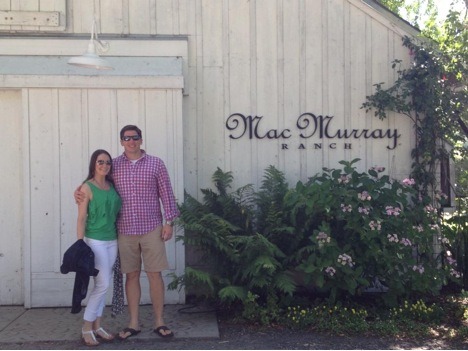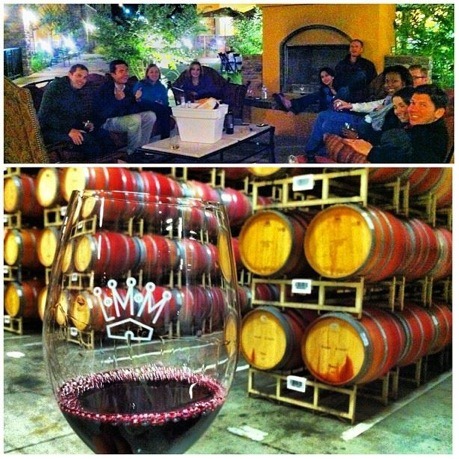SUMMER INTERN SERIES: NEIL HARBER – Gallo Winery Internship Overview
Greetings from Gallo! I want to give a little bit of background on E&J Gallo before going into details on my internship and project. Ernest and Julio Gallo officially started making wine in 1933 at the end of Prohibition and produced over 444,000 gallons of wine by the end of 1934. Over time, Gallo has grown considerably in terms of wine and vineyards, but it also vertically integrated a number of their operations by opening a glass plant, labeling and closures facility, logistics service, and a wine making consulting group. With the success and integration over the years, Gallo has become the largest winery in the world. Our brand portfolio spans from our value and popular selections like Barefoot, Carlo Rossi, Peter Vella, and Gallo Family to our of premium brands like Louis M. Martini, Ghost Pines, MacMurray Ranch, and Apothic to name a few. In total, Gallo has over 60 wine brands out on the market.
Here I am “thieving” some Merlot at the Frei Brothers Winery (pronounced fry, not fray). A wine thief is the glass pipette that I am holding and is used to sample the wine from the barrels. The barrel has a red tint to it from people spilling the wine (like I did) as they pull out samples and not from the wine soaking through the oak:

Like I said, Gallo is big. In fact, Gallo is the world’s largest winery and produces over 85 million cases per year (there are 12 bottles in a case if you want to know how many bottles). Our growth alone last year would have made us the 6th largest winery in the world. To understand the overall scale of the operations, most wineries in Napa and Sonoma produce about 3,000-4,000 cases per year, which Gallo could bottle in about an hour. Plus, we don’t just make wine. Distilled spirits are a big portion of our portfolio with brands like New Amderstam Gin and Vodka, E&J Brandy, Camarena Tequila, and Shellback Rum. I don’t think Gallo plans on venturing into beer or bourbon, but you never know!
For the summer, Gallo hired nine interns from Northwestern, UVA, Duke, Michigan, UC San Diego, and Dartmouth. We work in finance, marketing, or operations and were placed in separate departments within each functional area. The intent behind this is to gain a better understanding of the options that are available for our first rotation in Gallo’s MBA Immersion Program. The MBA Immersion Program is Gallo’s version of a three-year rotational leadership program that trains, educates, and develops the future leaders at Gallo. I will go into more detail on this subject for my last post since this program is currently being re-launched.
My project for the summer is to build a structured category analysis and clean sheet model on the closures (corks, screw caps, capsules) category in order to allow Gallo to manage suppliers more strategically. The analysis will include a “should cost” model for each closure, as well as a strategic cost driver dashboard that allows the supplier development team to monitor the cost trends for each component. Cost is not the only factor considered when selecting the appropriate closure. Each closure, whether it is a natural cork, technical cork, synthetic, or screw cap, performs differently in its ability to transfer oxygen and prevent cork taint. There is also the amount of reduction and ageability of the wine that is taken into consideration. Finally, the consumer’s perception is carefully accounted for when choosing the proper closure. Using a screw cap or a synthetic cork does not have the same level of elegance that a natural cork does when removing it from the bottle.
Aside from the project, the other aspect of any internship is understanding how you fit into the culture of the company. Gallo has submerged myself and the other interns into the culture by allowing us to tour a variety of their wineries and facilities, while also participating in sales and marketing training. We also engaged in numerous meet & greet’s, dinner events, and happy hours. All of this has been helpful in understanding not only the culture, but also in educating us on the overall complexity of the wine industry. By the end of the summer, we will have a reasonable grasp of the winemaking process from vine to store.
My wife and I are posing for a picture outside of the original barn at the MacMurray Ranch. MacMurray Ranch has a long and remarkable history that I would encourage you to check out on their web site:

The Fun Stuff:
Part of our education at Gallo was a weekend trip to Napa and Sonoma to visit four of Gallo’s wineries. We visited Louis M. Martini and William Hill wineries in Napa, while making stops in Sonoma at MacMurray Ranch and Frei Brothers. We had a tour and tasting at each winery to give us a better understanding of the winemaking process and the type of varietals (the grape that is used to make the wine) that each winery specializes in making. We also had some amazing meals at each winery that were provided by some of the best chefs in wine country.
This was our second wine tasting of the day at the Louis M. Martini cellar, which I believe was the 2009 Cabernet Sauvignon Monte Rosso. This is all of the interns and a couple of the significant others. I am in the plaid shirt with the hospitality host on my right. I think it’s worth mentioning that the size of these tanks are roughly 3000 gallons; Gallo has a tank for Carlo Rossi on its campus that holds over 1 million gallons!:

An event that I really enjoyed was the wine blending that we did at MacMurray Ranch. During this event, we made a personal blended wine from four different varietals, Zinfandel, Merlot, Syrah, and Petite Sirah. We used Zinfandel as our base and having to account for over 50% of the bottle. I made my blend to be 60% Zinfandel, 20% Merlot, and 10% each of the Syrah and Petite Sirah. I haven’t opened it yet since I think it may need a little aging to fully deliver the taste that I want. Just kidding. I am just waiting to open it once I get back home in Atlanta.
Another educational aspect of weekend was a competitive aroma event where we had to identify the appropriate scent that the host infused into 10 separate glasses of wine. Each glass had a common aroma that you might detect in any red or white wine. Even though my team was a group of interns, we won the competition and had bragging rights for the rest of the weekend. Overall, it was an amazing weekend and quite the “wining and dining” experience.
Next time I will talk about the Gallo MBA Immersion Program, the Intern Wine Bracket (similar to the NCAA March Madness), what it’s like living in Modesto and the Central Valley, and any concluding thoughts on my project and the internship.
The top photo is the group of interns enjoying some beverages at The Meritage hotel in Napa. The bottom photo is a Louis M. Martini wine glass taken in the cellar at LMM. One of the other interns took the bottom picture because I am artistically limited. I’m sure there’s a name for how this was taken, but I don’t know what it is (see artistic comment):

